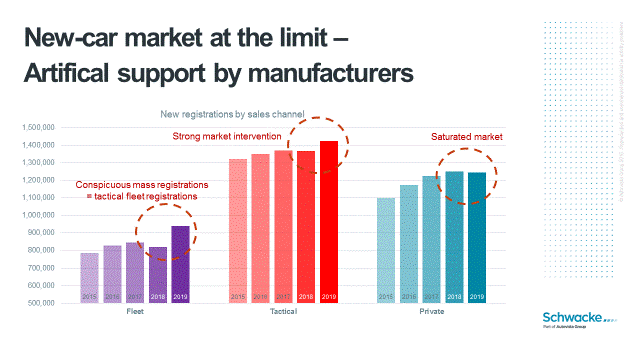The German new-car market is reaching its limits
27 February 2020

27 February 2020
The December and full-year new-car registration figures released by the German motor vehicle authority, the Kraftfahrt Bundesamt (KBA), are always eagerly awaited at the beginning of the year. These results are the best source for independently and transparently measuring the success and failure of the industry, brands and models in Germany. However, the registration figures are often reported as ′sales’ or ′demand’, which is rather misleading as the new-car market is essentially a used-car ′factory’, writes Andreas GeilenbrÃœgge, head of valuations and insights at Schwacke.
If, for example, you take all the cars registered for the first time by dealers and manufacturers, you get a share of almost 30% of the overall market. If you add the registrations by car-rental companies, the market share adds up to around 40%. This means that four out of 10 vehicles only find their actual, longer-term first-time owner within 12 months after their first registration and have limited, if any, operational use as a young used car. Moreover, this 40% share of the market can be influenced to a large extent by manufacturers and their sales management and, with corresponding discounts, form a major pillar of the used-car trade.
The second major pillar is fed by commercial and fleet registrations, which also reappear on the used-car market – usually as a leasing return, after an average of three years of use as a company vehicle. These registrations make up a further quarter of the total market.
Was 2019 really a successful year?
The sales channel for commercial registrations also significantly contributed to the growth to the record total of 3.6 million new cars in 2019. Compared to 2018, commercial registrations were up almost 120,000 units, or 14%. Registrations by dealers, manufacturers and rental companies delivered further growth of almost 60,000 cars, or about 4%. Actual sales to private buyers, which only account for about a third of the total market, had to contend with a minimal decline of 5,000 units.
Private new-car sales appear to be stagnating but there are significantly more young used cars available and, at first glance, company fleets seem to have invested properly in 2019. You could say that the past year was positive overall but the downside is the growing supply of used cars, which will burden price levels in both the short and long term.
To fleet or not to fleet – Fleets misused
It is worth taking a closer look at the so-called ′real’ commercial registrations. They are called ′real’ because they are not carried out by companies such as car dealers, manufacturers, importers or car-rental companies. They are supposed to reflect real demand in company fleets and small businesses.
However, there have been conspicuous mass registrations (numbering thousands or even tens of thousands) in some regions in recent years, which far exceed the realistic fleet demand. Although this cannot be determined exactly, these large volumes of cars from a few different manufacturers are seemingly registered by independent companies. These registrations serve no other purpose other than to make a cheap used car out of a new car and are inconspicuously reported in the KBA statistics as ′commercial’. Without actual commercial use, these cars should essentially be regarded as registrations by dealers or manufacturers. A not inconsiderable proportion of these cars are exported, depending on their fuel type and the capacity of the local market to absorb them. Nevertheless, the majority come to the market as a young used car within 12 months – in addition to those after three years. They provide additional competition, benefitting price-conscious used-car buyers.
In summary, the new-car market is being artificially kept at a high level and, truthfully, has long been a ′factory’ for used cars. The healthy growth in 2019 should therefore not be carelessly considered as a success and the ongoing market distortion represents a certain risk for the industry.
 This article also appears in German on the Schwacke website here.
This article also appears in German on the Schwacke website here.
 This article also appears in German on the Schwacke website here.
This article also appears in German on the Schwacke website here.